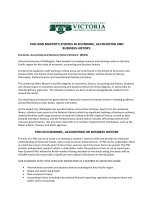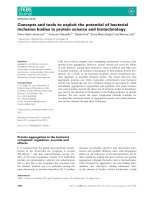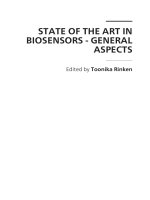studies in surface science and catalysisAAAA4cMETHODS FOR MONITORING AND DIAGNOSING THE potx
Bạn đang xem bản rút gọn của tài liệu. Xem và tải ngay bản đầy đủ của tài liệu tại đây (8.92 MB, 471 trang )
A
studies in surface science and catalysis
A
A
A
4
METHODS FOR MONITORING AND
DIAGNOSING THE EFFICIENCY OF
CATALYTIC CONVERTERS
A
Patent
-
oriented Survey
Marios
Sideris
c
This is Volume
14
of the
EPO
Applied Technology Series. The following
books
have appeared previously
in
this series:
Volume
Volume
Volume
Volume
Volume
Volume
Volume
Volume
Volume
Volume
Volume
Volume
Volume
1
2
3
4
5
6
7
8
9
10
11
12
13
CARDON
&
FRANSEN
LAMMINEUR
&
CORNILLIE
BRACKE et al
HOORNAERT
GEISLER et al
JACOBS et al
CRISTOL
CORNlLLlE
&
DAVIES
MlCHlELS
&
DE HERDT
DERAEDT
DHEERE
HERMANN
ONSHAGE
Dynamic Semiconductor
RAM Structures
Industrial Robots
Inorganic Fibres
&
Composite
Materials
Reverse Osmosis
Optical Fibres
Nickel &Cobalt Extraction
Using Organic Compounds
Solid State Video Cameras
Microprocessors
Molecular Sieve Catalysts
Methods of Abating
Residual Formaldehyde in
Industrial Resins
Universal Computer
Interfaces
Protein Folding
Mercury Cadmium
Te
I I
u rid e
I
mag e rs
115
METHODS FOR MONITORING AND
DIAGNOSING
THE EFFICIENCY OF
CATALYTIC CONVERTERS
A Patent-oriented Survey
Studies in Surface Science and Catalysis
Advisory
Editors:
B.
Delmon
and
J.T.
Yates
Vol.
115
METHODS FOR MONITORING AND
DIAGNOSING THE
EFFICIENCY
OF
CATALYTIC CONVERTERS
A
Patent-oriented Survey
Marios Sideris
European Patent Office,
Rijswijk,
The Netherlands
1998
ELSEVIER
Amsterdam
-
Lausanne- New
York-Oxford-Shannon-Singapore-Tokyo
ELSEVIER SCIENCE B.V.
Sara Burgerhartstraat
25
P.O.
Box
21 1,1000
AE Amsterdam,The Netherlands
Library of Congress Cataloging in Publication Data.
Acatalog record from the Libraryof Congress has been applied for.
ISBN
0-444-82952-0
0
1998
Elsevier Science
B.V.
All rights reserved.
No
part of this publication
may
be reproduced, stored in a retrieval system or transmitted in any
form or by any means, electronic, mechanical, photocopying, recording or otherwise, without
the prior written permission
of
the publisher, Elsevier Science B.V., Copyright
&
Permissions
Department,
P.O.
Box
521,1000
AM Amsterdam,The Netherlands.
Special regulations for readers
in
the U.S.A.
-
This publication has been registered with the
Copyright Clearance Center Inc. (CCC).
222
Rosewood Drive, Danvers, MA
01923.
Information can
be obtained from the CCC about conditions under which photocopies of parts of this publication
may be made in the U.S.A. All other copyright questions, including photocopying outside
of
the
U.S.A., should be referred to the publisher.
No responsibility is assumed by the publisher for any injury and/or damage to persons or
property as a matter of products liability, negligence or otherwise, or from any use or operation
of any methods, products, instructions or ideas contained in the material herein.
@The paper used
in
this publication meets the requirements of ANSI/NISO
239.48-1992
(Permanence of Paper).
Printed
in
The Netherlands
Methods for Monitoriw and Diamosiw the Efficiencv of Catalvtic
Converters
Summary
The evolution
of
methods concerned with on-board (OBD) and non-OBD monitoring and
diagnosing of efficiency of catalytic converters of internal combustion engines is described
based
on
patents and published patent applications. Non-patent references are also used.
The basic principles of modem catalytic converters
are
described in an extensive Introduction,
where the importance
of
monitoring and diagnosing the efficiency of catalytic converters
is
demonstrated.
The book is divided into four parts. The first part describes methods involving the use of
oxygen or airhel ratio exhaust gas sensors to determine the oxygen storage capacity of a
catalytic converter. The second part describes methods involving the use of temperature
sensors to determine the exothermic reaction capacity
of
a catalytic converter. The third part
describes all other methods existing
in
patent literature that monitor and diagnose the efficiency
of catalytic converters. The great majority of the methods of the third part involves exhaust gas
concentration measurements. The fourth part comprises a general discussion of all methods
described.
In the beginning of each part, a short introduction is given to explain the problem that the
methods attempt to solve. The methods in each part are presented
in
chronological order per
patent applicant. This helps to evaluate how the patent applicant has improved his methods
over time.
A
patent number index with information about the patent applicants, inventors, priorities and
patent-families, an inventor index, a company index and
a
subject index can be found at the end
ofthe book.
vi
i
Preface
The dramatic evolution of catalytic converters in the last thirty years was a result of a need
worldwide to reduce pollution created by the exhaust gases
of
internal combustion engines.
Environmental concerns have led American, Japanese and European Union
(EU)
legislation to
pose continuously stricter emission limits for petrol engines in the last decades.
The catalytic converter has become the most important means
of
exhaust treatment to achieve
the desired emission limits. The international legislation has also created a need for a regular
assessment of the efficiency of the catalytic converter
in
order to detect a deterioration
of
its
conversion efficiency as soon as this deterioration takes place. The assessment of conversion
efficiency of a catalytic converter can take place during normal driving of a vehicle (on-board
diagnosis
or
OBD)
or
in
a workshop by specialized technicians. The most important methods
nowadays are the OBD methods.
This book is an attempt to describe the evolution
of
methods concerned with on-board
(OBD)
and non-OBD monitoring and diagnosing of the efficiency
of
catalytic converters
of
internal
combustion engines based mainly on patents and published patent applications.
A
limited
amount of non-patent literature has been also used. All patent and non-patent documents cited
in
this book originate from the systematically classified documentation of the European Patent
Ofice (EPO). For the Japanese patent literature the technical abstracts published in English by
the Japanese Patent Office have been used.
The presentation has been focused
on
the sequence
of
steps used by each method
to
assess the
conversion efficiency of a catalytic converter. Only
a
limited number of engine measuring set-
ups and associated instruments used are described in detail to reduce the material
to
a
manageable size. It should be noted that
no
verification
of
the feasibility of a method
or
a
device or a measuring instrument
or
even the operation of a device
or
a measuring instrument
is needed to render them patentable.
The methods in each part are presented in chronological order per patent applicant. This helps
to evaluate how the patent applicant has improved his methods over time. The patent
or
patent
application number, the name of the applicant and the date of publication
are
indicated for each
document cited in the book.
A
patent number index, an inventors index, a company index and a
viii
Methods for Monitoring and Diagnosing the Efficiency of Catalytic Converters
subject index is found at the end of the book.
A
list of the non-patent literature used is also
cited at the end of the book.
It is not unusual that the patent applications have been filed
in
several countries, each referring
to a common first filing
i.e.
priority. These applications are said to belong to the same patent-
family. In this book the earliest published document of a patent family has been selected to be
cited. The reader may choose to consult a family document published in another language from
the patent numbers index found at the end of the book.
The basic principles of modern catalytic converters are described
in
an extensive Introduction,
where the importance
of
monitoring and diagnosing the efficiency of catalytic converters is
proven.
The book is divided into four parts.
The first part describes methods involving the use
of
oxygen
or
aidfuel ratio exhaust gas
sensors to determine the oxygen storage capacity of a catalytic converter.
The second part describes methods involving the use of temperature sensors to determine the
exothermic reaction capacity of a catalytic converter.
The
third
part describes all other methods existing
in
patent literature that monitor and
diagnose the efficiency of catalytic converters. The great majority of the methods of the third
part comprises exhaust gas concentration measurements.
The fourth part comprises a general discussion of all methods described.
I
would like to thank the editor, Simon Behmo, for his help and interest
in
this book, the
directors Jean-Marie Schmitter and Hermann Nehrdich for their support, the director Roland
Wohlrapp and my colleagues Simon Mansell, Alan Fordham, Peter Raven and Panos
Triantaphillou for critically reading the manuscript and for their many helpful suggestions.
For permission
to
use certain figures and tables, thanks are extended to the Society
of
Automotive Engineers
(SAE),
to the Institution of Mechanical Engineers, to Springer-Verlag
Wien-New York, to Elsevier Science
B.V.
and to the publishers of Automotive Engineer and
Automobiltechnische Zeitschrifi (ATZ).
I
must not end without an expression of immense gratitude to
my
wife Virginia and to my
sons
Theodore and Dimitrios for their understanding and support which they have given me during
the writing of this book.
Rijswijk, February
1998
Marios Th. Sideris
ix
Contents
Summary
Preface
Symbols and Abbreviations
Note
on Cited Patent Documents
V
vii
xiii
XV
Introduction
1
k3wlutioti
of
legislatioti
Materials used
iii
c~icr/c~lyl~c
converters
Tjpes
of
catalytic cwiverters
Electric heaters
Afterburners
Fuel
burners
Close-coupled converters
Secondary converters
Hydrocarbon adsorbents
Secondary
air
Other systems
to
facilitate light-off temperature
'ontrol
~f
catalytic comarters diirrtig a cold erigirie start-up
of
catalytic converters
Oxygeii ,storage
Monitoring and diapimirig the efjcieiicy
of
catalytic converters
2
8
12
18
18
19
19
21
21
22
22
23
24
25
Part One: Catalytic Converter Functionality Diagnosis by Means
of
Oxygen
or AirlFuel
Ratio
Sensors
31
A-probe
arid
UEGO
sensor operation priiiciples
Control
of
engine air!ftcel ratio
35
39
1.1
Robert Bosch GmbH
43
1.2
Daimler-Benz
AG
59
1.3
Ford
Motor
Co.
-
Ford France
SA
-
Ford Werke
AG
-
Ford
Motor
CO.
Canada
-
Ford
Motor
Co. Ltd.
63
80
83
113
117
129
I.Jigines wilh mrrltiple cylinder
groiips
1.4
Toyota Motor Co. Ltd.
I
.5
Nippon Denso
Co.
Engines wiih mtrliiple cylinder
groups
Engines with mirltiple cylitider
grotlps
x
Methods
for
Monitoring and Diagnosing the Efficiency
of
Catalytic Converters
1.6
Honda Motor Co. Ltd.
1.7
Hitachi Ltd.
Engines with mtrltiple cylinder
groups
Pltrrality
of
catalytic converters arranged
in
series
k
the exhairst pipe
1.8
Mazda Motor Corporation
Engines with
mwlt
iple cylinder
groups
1.9
Siemens Automotive SA
-
Siemens AG
1.10
NGK Spark Plug
Co.
1.1
1
Suzuki Motor Corporation
1.
I2
Mitsubishi Motors Corporation
-
Mitsubishi Electric Corporation
1.13
Nissan Motor Co. Ltd.
1.14
General Motors Corp.
Engines
wi
th mwltiple cylinder
groirps
Pl~walify
of
catalytic converters arranged
lit
series
in
the exha~rst pipe
1.15
Fuji Heavy Industries Ltd.
1.
I6
Other methods
0
e
e
e
e
a
e
e
0
e
0
a
a
e
e
e
0
0
e
Lucas Industries Public Ltd Co.
Magneti Marelli S.p.A.
Pierburg GmbH
&
Co.
KG
Bayerische Motoren Werke AG
The
United States Environmental Protection Agency
Weegen, Rainer
HAT
Auto S.p.A.
Volkswagen AG
Roth-Technik GmbH
&
Co.
Forschung
fir
Automobil- und
Umwelttechniek
Unisia Jecs Corp.
FEV Motortechnik GmbH
&
Co.
Hyundai Motor
Co.
Osaka Gas
Co.
Ltd.
Automobiles Peugeot
-
Automobiles Citroen
I3igines with
midt
iple cylinder
groups
Volvo AB
Denso Corp.
VDO
Adolf Schindling AG
Regie Nationale des Wsines Renault SA
Deutsche Fernsprecher GmbH Marburg
Other methods
Engines with midtiple cylinder groups
Part
Two:
Catalytic Converter Functionality Diagnosis
by
Means
of
Temperature Measurements
13 1
143
145
157
161
165
169
175
179
187
197
206
207
212
213
215
215
216
217
217
218
219
220
22
1
22 1
22 1
222
223
223
224
225
225
226
226
228
228
230
23
0
23
1
xi
Temperature setisors used
in
monitoring
of
catalytic converters
23
5
2.1
Emitec Gesellschafl Emrnissionstechnik
fir
Emissionstechnologie
239
2.2
Nissan Motor Co.
253
2.3
Robert Bosch GmbH
259
2.4
Volkswagen AG
265
2.5
Ford Motor Co.
-
Ford France SA
-
Ford Werke AG
-
Ford Motor Co.
269
2.6
Siemens AG
-
Siemens Automotive SA
-
Bayerische Motoren Werke AG
-
-
Dr. Ing. H.c.F. Porsche AG
Canada
-
Ford Motor Co. Ltd.
Mercedes Benz AG
2.7
Toyota Motor Co. Ltd.
2.8
NGK Insulators Ltd.
2.9
General Motors Corporation
2.10
Other Methods
e
e
e
0
0
0
0
0
0
Audi AG
Hitachi Ltd.
FIAT Auto S.p.A.
Universal Oil Products Co.
Willard
R.
Calvert,
Sr.
Phywe Systeme GmbH
Lucas Industries PLC
Mazda Motor Corp.
Roth-Technik GmbH
&
Co. Forschung
fir
Automobil- und
Umwelttechniek
Unisia Jecs Corp.
NGK Spark Plug Co. Ltd.
Honda Motor Co. Ltd.
Other Methods
Part Three: Other Methods
for
Diagnosing
the Efficiency
of
Catalytic
Converters
Exhaust gas coticetitrution
semen
Monitoring arid diapiositig
set-tip
3.1
Ford Motor Co.
-
Ford France SA
-
Ford Werke AG
-
Ford Motor CO.
Canada
-
Ford Motor Co. Ltd.
3.2
Volkswagen
AG
-
General Motors
Cop.
3.3
Hitachi America Ltd.
-
Hitachi Ltd.
3.4
Robert
Bosch
GmbH
3.5
Other methods
e
Monsanto
Co.
0
Beckrnan Industries. Inc.
277
283
295
301
305
305
305
306
306
306
3 06
306
308
308
308
308
309
309
311
3
14
319
321
325
329
333
335
335
336
xii
Methods for Monitoring and Diagnosing the Eflciency
of
Catalytic Converters
Technische Universitat “Otto von Guericke” Magdeburg
Toshiba Corp.
Gutmann Messtechnik AG
Nissan Motor Co. Ltd.
ABB Patent GmbH
Blanke,
J.
D.
Effort
Mijdrecht
B.V.
Keesmann, T.
Honda Motor Co. Ltd.
Iris-GmbH
infrared
&
Intelligent sensors
Hagen
&
Schildkamp Techniek B.V.
Roth-Technik GmbH
&
Co. Forschung fir Automobil- und
Umwelttechniek
NGK Insulators Ltd.
Fuji Heavy Ind. Ltd.
Toyota Motor Co Ltd.
Forskarpatent
I
Linkoping AB
Komatsu Ltd.
Leybold AG
Osaka Gas Co. Ltd.
Sun Electric UK Ltd.
Other Methods
Part Four: Discussion and Comparison
of
Existing Methods
Ike
oJA
or
oxygeti
setisom
[he
qf
iernpera/we seiisors
Use
?f
exhausst
gas
coricen/rafioFi
,sensors
References
Patent Number Index
Inventor Index
Company Index
Subject Index
337
338
338
338
339
340
340
34
1
341
341
341
342
342
344
344
345
345
346
346
346
349
35
1
3 54
3
57
359
361
363
409
429
435
XI11
Symbols and Abbreviations
a
A
ArF
b
CA
CARB
CP
CPU
DF
E
ECU
EHC
EGO
EGR
EPA
EPO
f
FTP
HEGO
i
I
I
C.E.
k
KI
K,
L
LED
LEV
m
MIL
NEEGO
NEDC
OBD
P
S
SAE
SOF
SCR
t
0
:
amplitude
:
Area
:
airhel ratio
:
amplitude
:
Crank Angle
:
California Air Resources Board
:
specific heat
:
Central processing unit
:
Dilution factor
:
Heat
:
Electronic control unit
:
Electrically Heated Catalyst
:
Exhaust Gas Oxygen Sensor
:
Exhaust Gas Recirculation
:
Environmental Protection Agency of United States of America
:
European Patent
Office
:
frequency
:
Federal Test Procedure
:
Heated Exhaust Gas Oxygen Sensor
:
Integral
:
Electric current
:
Internal Combustion Engine
:
constant
:
integration correction amount
:
skip correction amount
:
length
:
Light emitting diode
:
Low
Emissions Vehicle
:
mass
flow
:
malfunction indication lamp
:
Non-Equilibrium Exhaust
Gas
Oxygen Sensor
:
New
European Driving Cycle
:
On-Board Diagnostics
:
phase shift
:
mass
flow,
volume
flow,
heat transfer rate
:
Area
:
Society
of
Automotive Engineers
:
Soluble Organic Fraction
:
Selective Catalytic Reduction
:
time
xiv Methods for Monitoring and Diagnosing the Eficiency
of
Catalytic Converters
T
TDC
UEGO
ULEV
V
WIPO
WS,W
Greek
Ak
h
E
z
@i
@j
@xx
@xy
:
time, period, time delay, temperature
:
Top dead center
:
universal exhaust gas oxygen sensor
:
Ultra-Low Emissions Vehicle
:
Voltage, oxygen storage value, velocity
:
World Intellectual Property Organization
:
Laplace transform transfer equation
:
k-1
exis fiiig oxygen conferit
actual erigine air
I
fuel ratio
or
stoichiometric oxygen
carlieill
14.7
:
threshold
:
time delay parameter
:
correlation fimction, deterioration index
:
complement fbnction
of
@i
:
auto-correlation function
:
cross-correlation function
S14hscripts
-
Sirperscripts
1
2
air
cat
f
FB
FC
HL
in
L
lean
lim
mean
02
R
real
ref
rich
tm
E
:
value referred to upstream sensor
:
value referred to downstream sensor
:
air
:
catalytic converter
:
filtered value
:
Feedback value
:
Fuel cut
:
Highload
:
value
of
a
property entering catalytic converter
:
lean
:
lean
:
limit
:
meanvalue
:
oxygen
:
rich
:
real
:
reference value
:
rich
:
value calculated by means of a theoretical model
:
threshold value
:
average
xv
Note on Cited Patent Documents
An
international two-letter country code
is
used for published patents and patent applications
i.
e.
AU
BR
CA
CH
CN
cz
DD
DE
DK
ES
EP
FR
GB
IT
JP
KR
NL
NO
RU
SE
su
us
wo
Australia
Brazil
Canada
Switzerland
China
Czechoslovakia
Deutsche Demokratische Republiek
(DDR)
Germany (Federal Republic)
Denmark
Spain
European (EPO)
France
Great Britain
Italy
Japan
Korea
The Netherlands
Norway
Russia
Sweden
Soviet Union
United States of America
World
Intellectual Property Organization
(WIPO)
The country code
is
followed by a one-letter publication code,
i.e.
First Publication Level
Second Publication Level
Granted Patent for
DE
documents
Reissue Patent
Translated
Utility Model
Introduction
In order to meet increasingly stringent restrictions on the emissions
of
certain polluting gases
by automotive internal combustion engines, it is common nowadays for the exhaust systems
of
such engines
to
include catalytic converters. The exhaust gas from the engine passes through
such converters and pollutant gas constituents are converted into
less
undesirable gases by the
catalytic action
of
the catalyst within the converter
for
venting to the atmosphere.
Catalytic
action
in general is the action
of
certain materials to provoke with their presence
in
a
suitable environment chemical reactions, without themselves being modified by this reaction. In
exhaust systems noble metals play the role
of
these catalytic materials
(cutufysts).
The dramatic evolution of catalytic converters in the last
30
years was a result of
a
need
worldwide to reduce pollution created by the exhaust systems
of
internal combustion engines.
Pollutants
hydrocarbons
(HC)
and
particles (e.g. carbon) are produced from the incomplete combustion
of
the aidfuel mixture in
the engine. These, in combination with the atmospheric conditions can lead to photochemical
reactions which generate smog and contribute to the production
of
acid rain.
Studies in the United States have shown that about
10
per cent
of
vehicles are responsible
for
50
per cent
of
the
CO
emissions at the sites studied. Besides, experience has shown that a
desired durability
(80000
Km)
of
anti-pollution systems
of
gasoline cars cannot be guaranteed
with high confidence levels. Therefore, special emphasis is given to tailpipe inspections and
maintenance programs
([
1
I).
Environmental concerns have led American, Japanese and
European Union
(EU)
legislation to pose continuously stricter emission limits
for
gasoline
engines over the last decades.
like nitrogen oxides
(NO,),
carbon monoxide
(CO),
1
2
Methods for Monitoring and Diagnosing the Efficiency
of
Catalytic Converters
Evolution
of
legislation
In general, petrol
or
spark-ignition engines emit oxides of nitrogen
(NO
and small amounts
of
NO2
-
collectively referred to
as
NO,),
carbon monoxide (CO) and organic compounds, which
are unburnt
or
partially burnt hydrocarbons (HC). Compression-ignition
or
diesel engines emit
smaller amounts
of
CO and HC, their main problem being particulate emissions
The Clean
Air
Act was the first law that sought to control auto emissions throughout the
USA. This law set I975 and I976 exhaust requirements at
1.5
@mile (0.93 g/km)
for
HC,
15
g/mile (9.37 dkm) for CO and
3.1
@mile (1.93 g/km) for
NO,.
Emission levels were measured by the Federal Test Procedure (FTP) established by the U.S.
Environmental Protection Agency
(EPA).
The
FTP
'75 test cycle simulates an
1
I-mile driving cycle through
Los
Angeles
at
an average
speed
of
34.1
Kdh. The
FTP
test
measures CO, HC and
NO,
with
a
constant volume
sampling system and involves
a
cold
start
afler an engine sits idle for eight hours,
a
hot start
and a combination of urban and highway conditions ([3]).
Fig.
I
shows the four phases
of
the American FTP '75 test cycle and the behavior
of
the HC in
exhaust. The four phases of an engine according to this test cycle is: the cold start phase, the
stabilized phase, the engine
off
phase and the warm phase. The upper part of the figure shows
the variation of the velocity of the vehicle vs. time whereas the lower part
of
the figure shows
the variation of HC emissions vs. time. It is obvious that from all phases, the cold start phase
produces most of the HC emissions
(80%)
([2]).
A change being
assessed
is
to expand the FTP to include conditions that involve aggressive
driving behavior at high speed and high acceleration, rapid fluctuation in speed, use
of
air
conditioners and start-up atter an engine
is
turned
off
for intermediate periods
(e.g.
30
minutes). This will result in higher space velocities and greater concentrations
of
pollutants,
which will place more demand on the converter.
Subsequent state and federal laws have set ever more stringent automobile emissions
standards. Amendments to
the
Clean Air Act
in
1990 phased
in
together standards over a
period that extends well beyond
2000.
Afler
1996, catalytic converters
in
new vehicles must
last
100000
miles. The standards for
2004
are:
0.125
g/mile (0.078 g/km) non-methane HC
Introduction
3
I
.7
g/mile
(1.062
&m)
CO
0.2
g/mile
(0.125
dkm)
NO,
California has even stricter laws.
For
example, non-methane
HC
emissions (NMHC) must be
0.075
g/mile
(0.046
g/km) by
2000
in
96%
of
all cars. Through the remainder
of
the 1990s,
California law stipulates standards
for
Transitional Low Emission Vehicles (TLEV), Low
Emission Vehicles (LEV) and
for
Ultra Low Emission Vehicles (ULEV)
(see
[3],
and
[4]).
PHASES
velocity
100
Km/h
50
0
0
125
500
1000
1500
2000
2500
100%~-;;~1
I
80%
100%
HC
50
0
1
!
*
0
125
500
1000
1500
2000
2500
time
(seconds)
Total
Emission
per
Test
-
FTP
'75
cycle
Fig.
1
(from
[2],
p.
19)
The first standards set in Europe to mandate the use of a catalytic converter were set by the
EC93 standards. This brought European standards to levels comparable with those that were
introduced
in
the
USA
in
the 1980s.
In
1997,
a second stage of European legislation was introduced for
all
new cars, covering both
petrol and diesel engines. These standards brought
EU
rules into line with
US
standards
introduced between
1994
and 1996.
A
third state of legislation
has
been proposed by the European Commission
to
set
emissions
standards for
2000
and beyond. It comes as a draft directive, which also proposes that petrol
vehicles with electronically controlled catalytic converters should be fitted with on-board
4
Methods for Monitoring and Diagnosing the Efficiency of Catalytic Converters
diagnostic (OBD) systems that indicate when emissions are not conforming to standard and
require hrther investigation
([SI).
Fig. 2 shows the
so
called New European Driving Cycle (NEDC) adopted
in
1989, that is used
in
the European Union at the present and corresponds to the USA FTP
'75
driving cycle of fig.
1
[34].
It has been applied since the beginning of 1993 to all passenger cars weighing less than
2500 kg. The driving cycle consists of two parts, a city driving part and
an
Extra Urban
Driving Cycle
(EUDC)
part. The EUDC part uses car speeds up to 120
km/h.
The city driving
part consists of an extremely high idling time part (31%) and engine breaking and the mean
driving speed
is
only
19
km/h.
In
this way the
NEDC
does not
filfil
the aspect of a
representative city driving and as
it
can be seen
in
fig.
3
it
covers only a small part of a real
engine operation field. This simply means that the emissions quantity allowed in this operation
range
of
an internal combustion engine is limited by the law. The comparison
of
the FTP
'75
and the NEDC cycles shows that the FTP
'75
cycle comprises a higher collection of load and
speed ranges when driving
in
the city than the corresponding European cycle
(fig.
3).
B
W
2
a2
40
0
B
I-
195
'
195
'
195
'
-start
of
end
of
cycle
7
time
(s)
end
of
cycle
7
400
time
(s)
test
duration
:
1220
s
test length
:
11,007
km
average cycle speed
:
32.5
km/h
max.
speed
:
120km/h
Fig. 2 (from
[34],
p.
161)
Table
1
shows the European exhaust emission standards (restrictions) for passenger cars for
the four
main
pollutants Le. carbon monoxide (CO), nitrogen oxides
(NO,),
hydrocarbons
(HC) and particles. The
EC96 (EURO
TI)
is
the current European standard (effective
January
1997),
whereas the EC2000
(EURO
111)
and EC2005 (EURO
IV)
correspond to the proposed
Introduction
5
European standards to be met
in
years
2000
and
2005
respectively (see also European directive
9411
2/EEC).
The last four columns correspond to the current
USA
Federal emission standards
(1996),
to the Californian
TLEV
(1996-1998+),
LEV (2000)
and
ULEV (2005)
emission
standards.
US
drimg
cycle
SS
EU
driving
cycle
1.4
1.2
1.0
0.8
0.6
0.4
0.2
onsumption
spec&
www
0
rotational
speed
@I’M)
Fig.
3
(from
[34],
p.
162)
As
Table
1
shows,
in
some respects the draft
2005
European regulations are more severe than
the Californian
ULEV
standards, which until now have been seen as very close
to
the limit
of
what is technically feasible
for
the internal combustion engine. The proposed European
2005
limit
of
0.25
g/km
NO,
for light duty diesel engines is completely beyond the diesel’s
technology reach unless one key technology, the
NO,
reduction catalytic converter, can be
brought to
full
effectiveness and to production
in
the meantime. It must be borne
in
mind that
the driving cycles
of
EC2005
and
ULEV
involved differ significantly (see
[6]
and
[7]).
For
the
TLEV,
LEV
and
ULEV
standards the HC is measured as non-methane organic gases
(NMOG).









